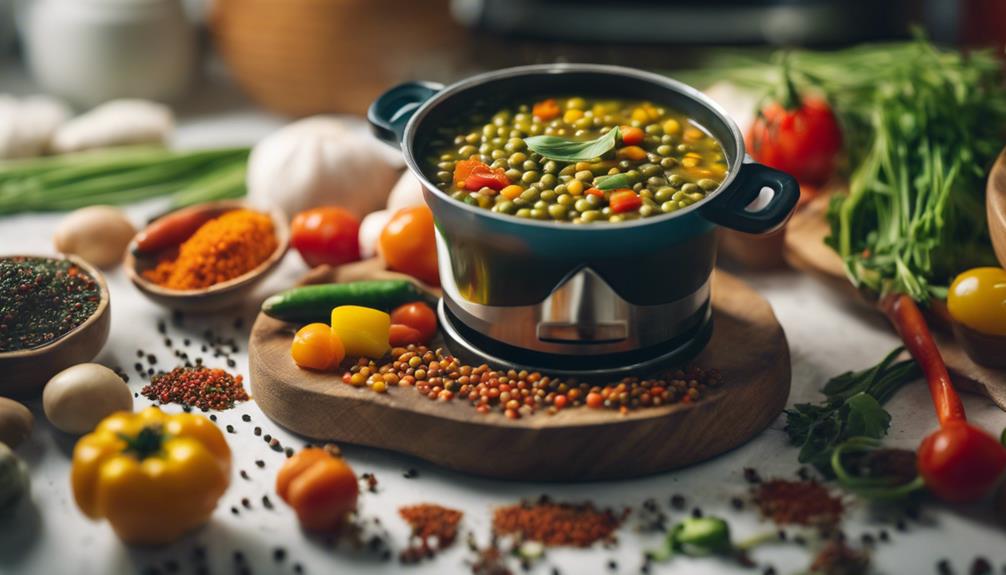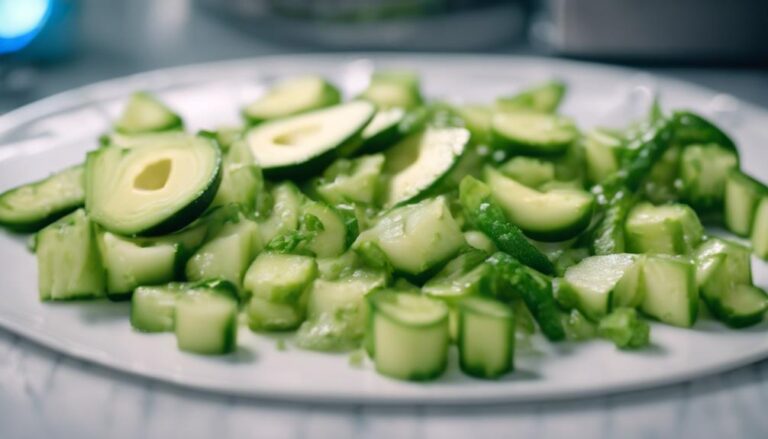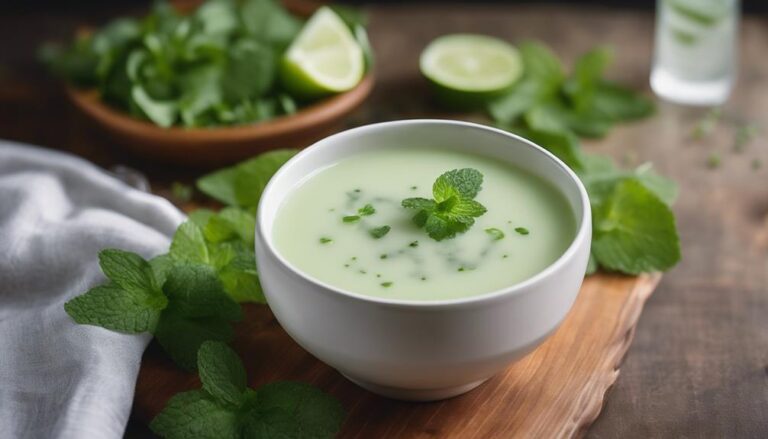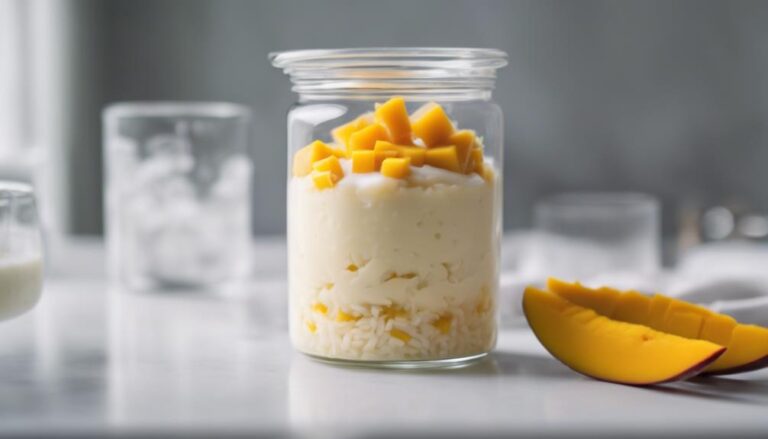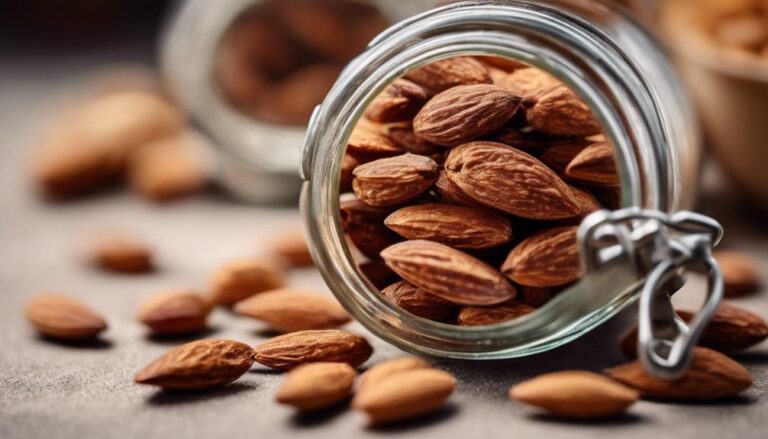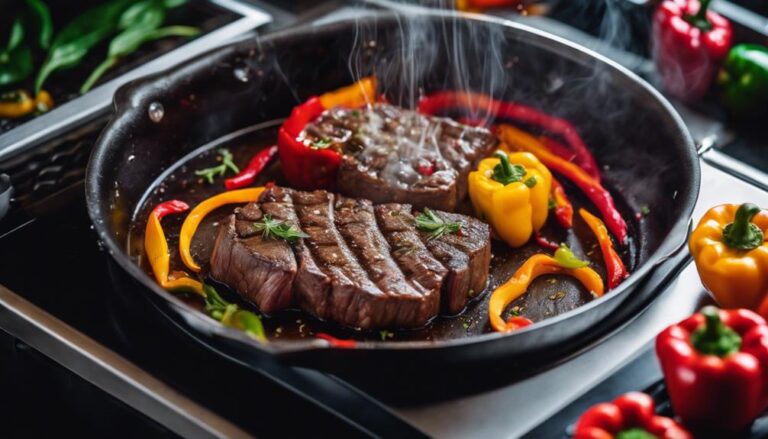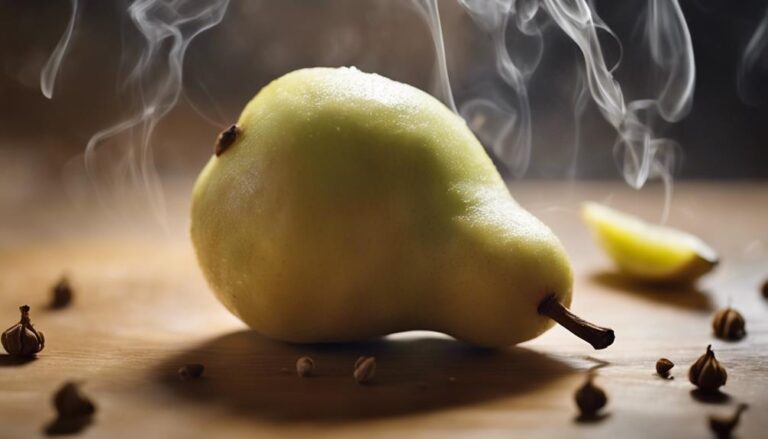Sous Vide Mung Bean Stew for All Doshas
Incorporate sous vide mung bean stew into your Ayurvedic diet for balanced doshas. Mung beans offer high protein, fiber, and essential nutrients. Enhance with aromatic herbs like cilantro, mint, or basil for a burst of freshness and added vitamins. Sealing ingredients in a bag via sous vide guarantees nutrients and flavor, perfect for mung beans. This method guarantees precise doneness and consistent cooking. Enjoy a nutritious and flavorful experience with mung bean stew suitable for all body types. For more on elevating your culinary journey with versatile mung beans, consider exploring the benefits further.
What You Will Learn Here
- Mung bean stew balances all doshas in Ayurveda.
- Sous vide cooking preserves mung beans' nutrients.
- Suitable for diverse body types and constitutions.
- Aromatic herbs enhance flavor and add nutrients.
- Customizable with various ingredients for dosha harmony.
Mung Bean's Ancient Origins

Mung beans hold a rich historical significance, originating in India over 4,000 years ago and forming an integral part of Ayurvedic cuisine.
Their exceptional nutritional profile, abundant in protein, fiber, vitamins, and minerals, underscores their status as a valuable ingredient in vegetarian diets.
The culinary adaptability of mung beans allows for their incorporation into a myriad of dishes, showcasing their enduring importance in diverse culinary traditions.
Ancient Mung Bean Cultivation
Having been cultivated for over 4,000 years, the origins of mung beans trace back to India before spreading to various regions across Asia.
Mung beans, one of the oldest legumes, are cherished for their nutritional value and adaptability in cooking. In ancient cultivation practices, mung beans thrived in well-drained soil with ample sunlight and consistent watering. Their high protein content, rich in essential amino acids, and digestive health benefits made them a popular choice in Ayurvedic cuisine.
The cultivation of mung beans played a significant role in sustaining populations across Asia, contributing to their reputation as a versatile and nourishing staple. Today, the tradition of growing mung beans continues, honoring their historical significance and culinary versatility.
Nutritional Value Highlights
The historical cultivation practices of mung beans reveal a deep-rooted tradition of nutritional significance and agricultural sustainability in ancient Asian societies. Mung beans, originating in the Indian subcontinent over 4,000 years ago, have been a staple in Ayurvedic cuisine due to their rich nutritional profile. These beans offer a substantial amount of plant-based protein, fiber, vitamins, and minerals, making them a nutritious choice for all doshas.
In Ayurveda, mung beans are considered tridoshic, meaning they help balance all body types, promoting overall health and well-being. Their easy digestibility aids in proper nutrient absorption and supports digestive health. When incorporated into dishes like a sous vide mung bean stew with ingredients like coconut milk, their nutritional value is preserved, enhancing both texture and flavor.
Culinary Versatility of Mung
Culinary practices throughout ancient civilizations have long showcased the remarkable adaptability and nutritional benefits of mung beans, also known as green gram. Cultivated for over 4,000 years in India and other parts of Asia, these legumes have become a staple in Ayurvedic cooking.
Rich in fiber, protein, antioxidants, vitamins, and minerals, mung beans offer a myriad of health benefits. Ayurveda recognizes their cooling effect on the body and deems them suitable for all doshas when prepared thoughtfully.
The culinary versatility of mung beans is evident in their ability to be sprouted, boiled, roasted, or ground into flour, making them a fundamental ingredient in a wide range of cuisines worldwide.
Versatile Mung Bean Additions
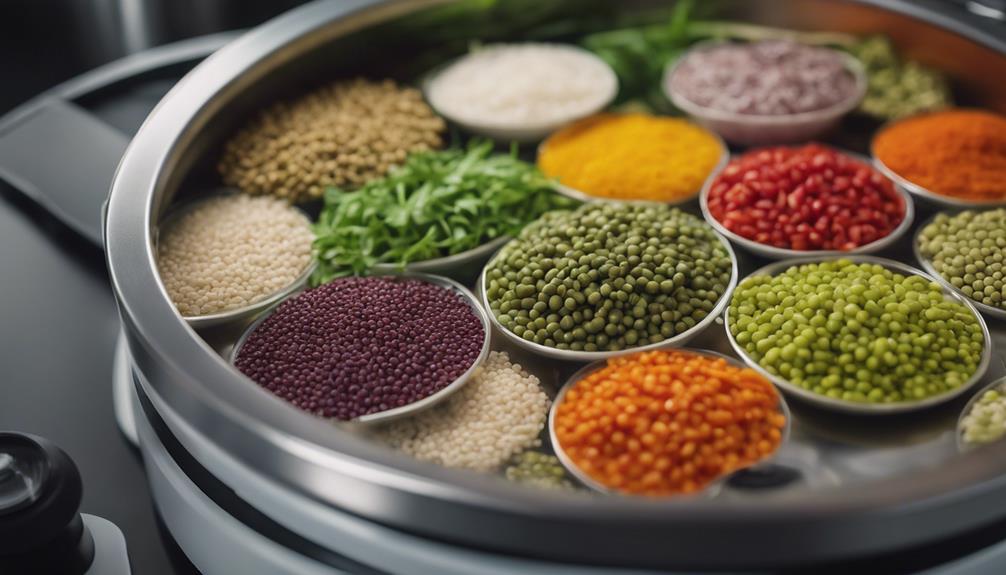
Consider incorporating a variety of vegetables, herbs, and spices into your mung bean stew for a customizable and nutrient-rich dish that aligns with Ayurvedic principles.
Enhance your mung bean stew with the following additions:
- Carrots: Adding carrots not only brings a pop of color but also contributes beta carotene, fiber, and sweetness to balance the earthiness of mung beans.
- Spinach: Incorporating spinach provides an excellent source of iron, folate, and vitamins A and K, boosting the stew's nutritional value and adding a vibrant green hue.
- Cilantro: Including cilantro not only imparts a fresh and citrusy flavor but also offers antioxidants and essential nutrients like vitamin C and vitamin K to support overall health.
Mouthwatering Mung Bean Creations
Explore the world of mung bean creations with dishes like:
- Mung Bean Curry Delight
- Spicy Mung Bean Tacos
- Mung Bean Coconut Soup
These innovative recipes showcase the versatility of mung beans and their ability to adapt to various flavor profiles.
Mung Bean Curry Delight
Incorporate mung beans into your culinary repertoire with the delectable Mung Bean Curry Delight. This flavorful and nutritious dish is suitable for all doshas in Ayurveda, offering a rich and satisfying curry experience.
Here are three key points to take into account when preparing this dish:
- Protein-Rich: Mung beans are an excellent source of protein, making this curry a nourishing option for vegetarians and vegans.
- Sous Vide Perfection: Utilizing the sous vide cooking method guarantees that the mung beans are perfectly cooked and infused with the aromatic flavors of the spices.
- Customizable Delight: Tailor your Mung Bean Curry by adding different vegetables and seasonings to cater to individual tastes and preferences.
Spicy Mung Bean Tacos
Moving on from the savory Mung Bean Curry Delight, explore the world of bold flavors with the Spicy Mung Bean Tacos, a tantalizing twist on traditional mung bean dishes. These tacos are a creative and flavorful way to enjoy mung beans, offering a plant-based, protein-rich meal suitable for all doshas in Ayurveda.
The mung beans, cooked sous vide, boast a perfectly tender and flavorful texture that pairs exquisitely with the variety of toppings and fillings you can customize them with. Here are three reasons why Spicy Mung Bean Tacos are a delightful choice:
- Versatile and customizable with various toppings and fillings.
- Combination of spices and seasonings adds depth and complexity to the mung beans.
- A delicious and satisfying meal option for those seeking bold flavors and plant-based protein.
Mung Bean Coconut Soup
Mung Bean Coconut Soup, a nourishing dish blending mung beans and creamy coconut milk, offers a harmonious balance of flavors and nutrients in a single bowl. This soup stands out for its nutritional value and delicious taste due to the combination of mung beans and coconut milk.
Here are three key points about this delectable soup:
- Nutrient-Rich: The incorporation of coconut milk adds a richness to the soup while providing essential nutrients like vitamins and minerals.
- Creamy Texture: The coconut milk contributes to a velvety and smooth consistency, enhancing the overall dining experience.
- Balanced Flavors: The mung beans and coconut milk complement each other perfectly, creating a well-rounded flavor profile that satisfies the palate.
Mung Bean Stew Enhancements
To enhance your mung bean stew, consider incorporating flavorful spice combinations like cumin, ginger, and mustard seeds for a more robust taste.
Experiment with texture-boosting ingredients such as seasonal vegetables like carrots, zucchini, or bell peppers to add nutritional value and varied mouthfeel.
Additionally, explore aromatic herb pairings like cilantro, parsley, or mint to introduce invigorating and fragrant notes to your stew.
Flavorful Spice Combinations
Enhance the depth of flavor in your Mung Bean Stew by skillfully combining spices like cumin, coriander, turmeric, and more. These spices not only add richness but also offer a range of health benefits.
For a balanced taste, consider incorporating ingredients like ginger, garlic, and asafoetida. Experimenting with pepper variations such as black pepper, peppercorns, or red pepper flakes can further elevate the stew's flavor profile.
To add an aromatic touch, try using spices like cardamom pods, cinnamon sticks, and bay leaves. Remember, adjusting the spice combinations and quantities can help customize the stew to suit your dosha.
For a final touch of brightness, a squeeze of fresh lemon juice can enhance the overall taste of your Mung Bean Stew.
Texture-Boosting Ingredient Options
Root vegetables like carrots, sweet potatoes, and parsnips can be excellent additions to augment both the texture and flavor profile of your mung bean stew. These vegetables not only provide a hearty and substantial base but also offer a slight sweetness that complements the earthy undertones of the mung beans.
Adding a variety of leafy greens, such as spinach or kale, can introduce a little green freshness and a pleasant textural contrast to your stew. Consider incorporating chopped mushrooms like shiitake for a savory umami boost and a meaty texture.
To further enhance the chewiness and satiety of the stew, mixing in cooked grains like quinoa or millet can be a great option. Experiment with these texture-boosting ingredients to create a well-rounded and satisfying mung bean stew.
Aromatic Herb Pairings
Consider incorporating a selection of fresh aromatic herbs like cilantro, mint, or basil to elevate the flavor profile of your sous vide mung bean stew. These herbs not only add a burst of freshness but also provide additional nutrients and antioxidants to the dish.
Cilantro is rich in vitamins A and K, mint offers digestive benefits, and basil is a good source of vitamin K and manganese. These herbs can aid in digestion and contribute to the overall health of your digestive tract.
Experimenting with different herb combinations can enhance the taste profile of the mung bean stew according to your preferences. Remember to add the herbs towards the end of the cooking process to preserve their vibrant colors and delicate flavors in the sous vide preparation.
Final Thoughts
In concluding the discussion on sous vide mung bean stew, it is important to reflect on the benefits of this cooking method for nutrient preservation and flavor enhancement. Sous vide cooking involves sealing ingredients in a bag and cooking them in a water bath at a precise temperature, which helps maintain consistent heat for even cooking. This technique is particularly advantageous for ingredients like mung beans, which can take a long time to cook conventionally. By utilizing sous vide, you can preserve the nutrients in the mung beans and enhance the flavors of the stew. Additionally, the sealed environment allows for precise control over the doneness of the beans and other ingredients, resulting in a perfectly cooked dish every time.
| Benefits of Sous Vide Mung Bean Stew |
|---|
| Nutrient preservation |
| Flavor enhancement |
| Precise control over doneness |
| Even cooking |
| Customizable to different doshas |
Frequently Asked Questions
Are Mung Beans Detoxifying?
Mung beans exhibit detoxifying properties due to their ability to cleanse toxins and aid digestion. They are rich in fiber, promoting bowel regularity and waste elimination. Including mung beans in your diet supports detox pathways, reducing inflammation.
Is Mung Beans Good for Acid Reflux?
Mung beans are excellent for acid reflux. Their alkaline nature helps neutralize excess stomach acid, easing discomfort. Consider mung bean alternatives in your diet for soothing effects on digestion, potentially managing acid reflux symptoms effectively.
What Are the Benefits of Moong in Ayurveda?
In Ayurveda, moong bean recipes offer various benefits. Moong beans balance all doshas, aid digestion, have a cooling effect, provide sustained energy, support muscle growth, and help detoxify the body. They are a versatile ingredient for overall well-being.
Do Mung Beans Need to Be Soaked Before Cooking?
When cooking mung beans, soaking is not mandatory, but it can help in reducing cooking time and enhancing digestibility. Sous vide methods eliminate the need for soaking, guaranteeing thorough cooking. Whether soaked or not, make sure mung beans are fully tender before consuming.
Conclusion
To sum up, incorporating sous vide mung bean stew into your diet offers a versatile and nutritious option for all doshas. With its ancient origins and endless possibilities for enhancements, mung bean stew is a delicious and satisfying dish that can be enjoyed by everyone.
Experiment with different ingredients and seasonings to create your own mouthwatering variations of this traditional recipe. Embrace the benefits of mung beans and elevate your culinary experience with this nourishing stew.
